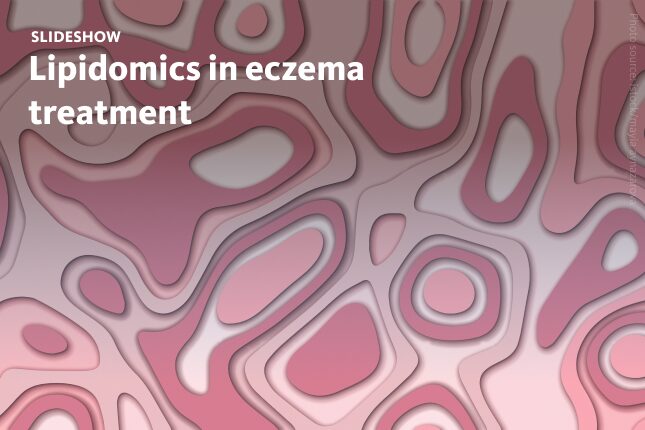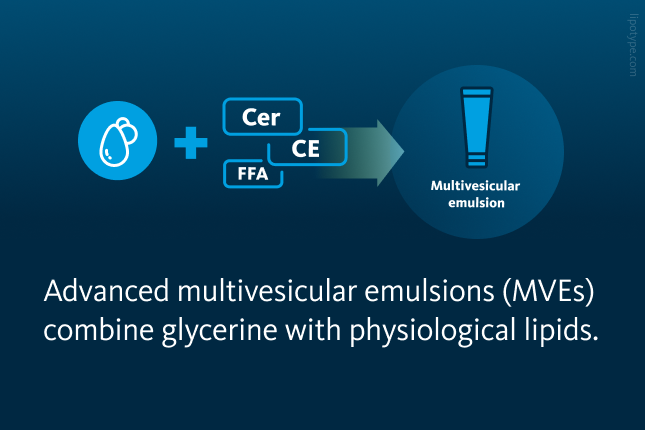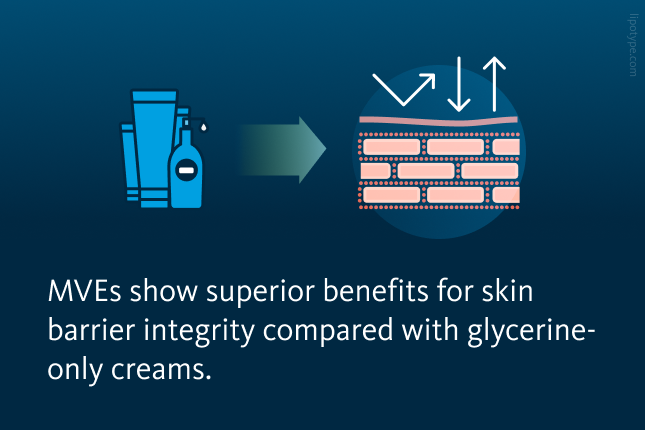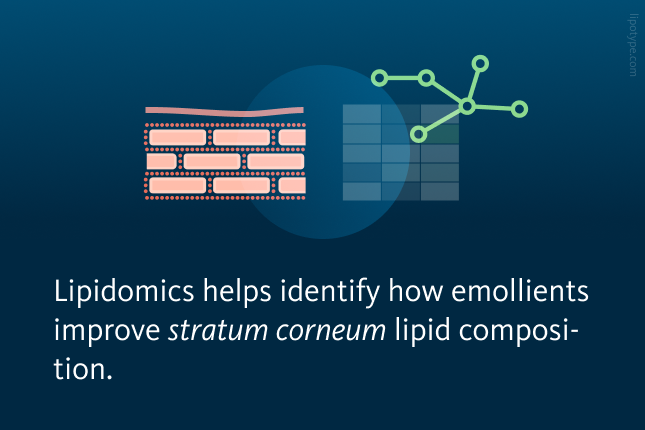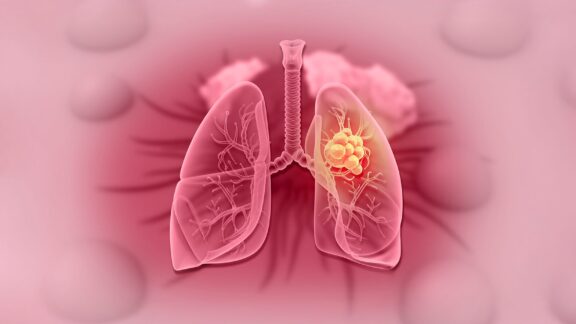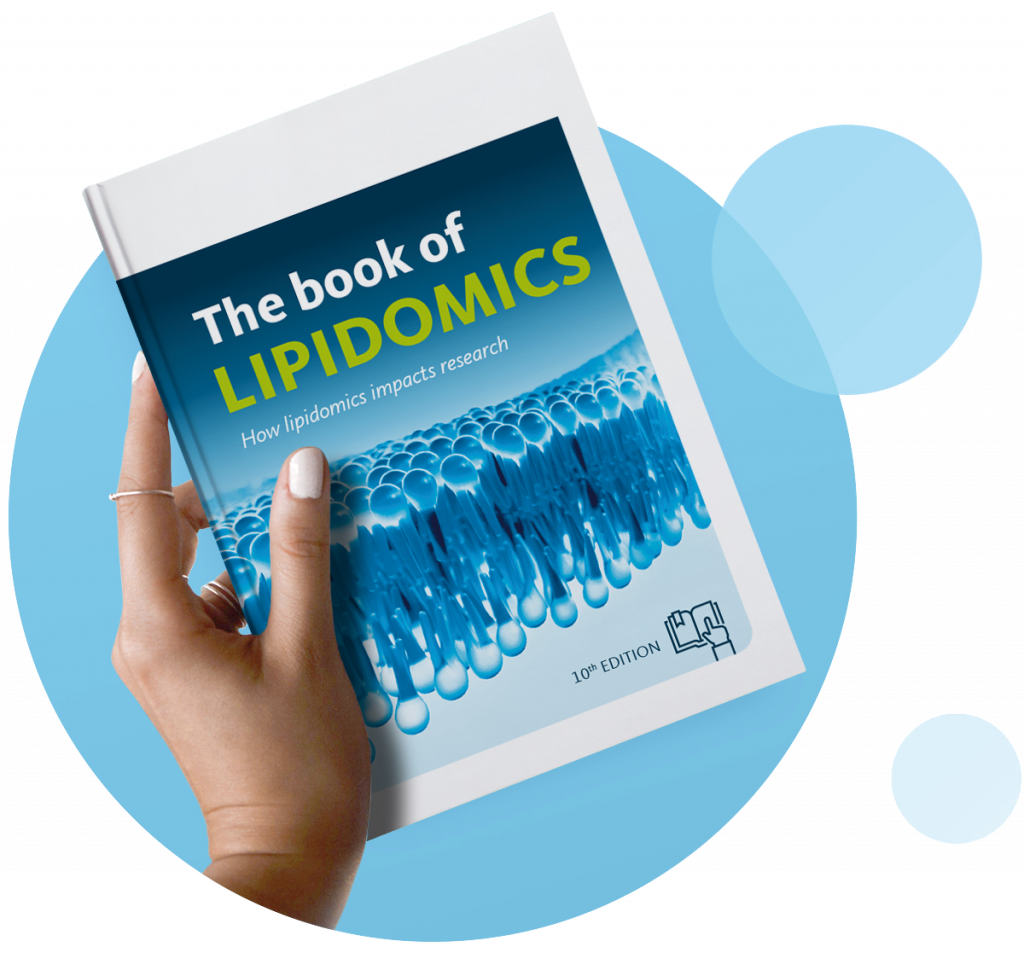THE skin’s barrier function is mainly located in the stratum corneum (SC), which consists of stacked layers of corneocytes surrounded by a lipid-rich structure called the lipid lamellae. These lamellae are primarily made up of ceramides, cholesterol, and fatty acids. Ceramides themselves contain a sphingoid base connected to a fatty acid (the acyl chain) via an amide bond. In human SC, researchers have identified more than a thousand ceramide species, and studies continue to explore how this diversity influences skin function in health and disease, in particular in conditions like eczema and atopic dermatitis.
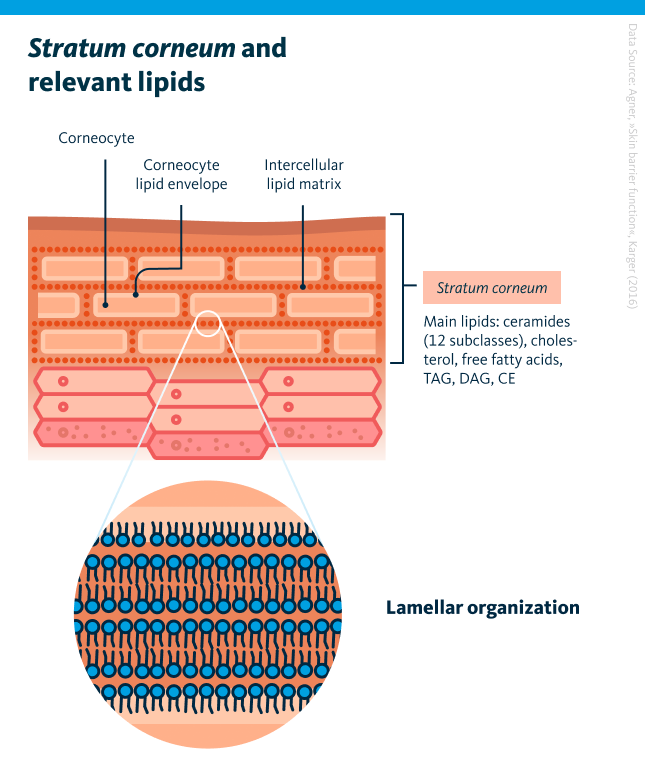
Eczema is a broad term for skin inflammation, and atopic dermatitis is its most common form. Eczema often presents with dry, itchy skin and a weakened skin barrier, which allows water to escape and irritants to enter more easily. One contributing factor to this barrier impairment is an imbalance in skin lipids, particularly ceramides.
Studies show that people with eczema frequently have altered lipid profiles in general and ceramide profiles in particular, and laboratory models suggest that restoring healthy ceramide composition can significantly improve skin barrier function. Creams designed to replenish lipids and enhance hydration can therefore help reduce water loss (so-called transepidermal water loss), strengthen the skin’s protective layer, and improve comfort in those with eczema.

Regular use of certain emollients in patients with eczema can also help extend the time between flare-ups and reduce the need for topical corticosteroids. However, their effectiveness can differ from one product to another, and there is still no strong consensus on which specific formulations or ingredients work best. Research indicates that emollients enriched with physiological skin lipids, such as ceramides, can strengthen the skin barrier and lead to better clinical results in eczema patients. What remains less clear is exactly how these products influence the detailed lipid composition of the stratum corneum during eczema.
Andrew and colleagues evaluated the effects of two different moisturizers: a multivesicular emulsion containing both physiological lipids and glycerine (MVE+GL) and a commonly prescribed oil-in-water emulsion with glycerine but no added physiological lipids (OW+G). In a double-blind, split-body study, 58 adults with a history of eczema applied MVE+GL emulsion to one forearm and lower leg, and OW+G emulsion to the opposite side, twice a day for 28 days. Skin condition was evaluated before and after the treatment period. This evaluation included, among other parameters, a detailed lipid analysis of stratum corneum samples. The goal was to compare how each formulation influenced skin barrier function and the lipid profile of the stratum corneum.
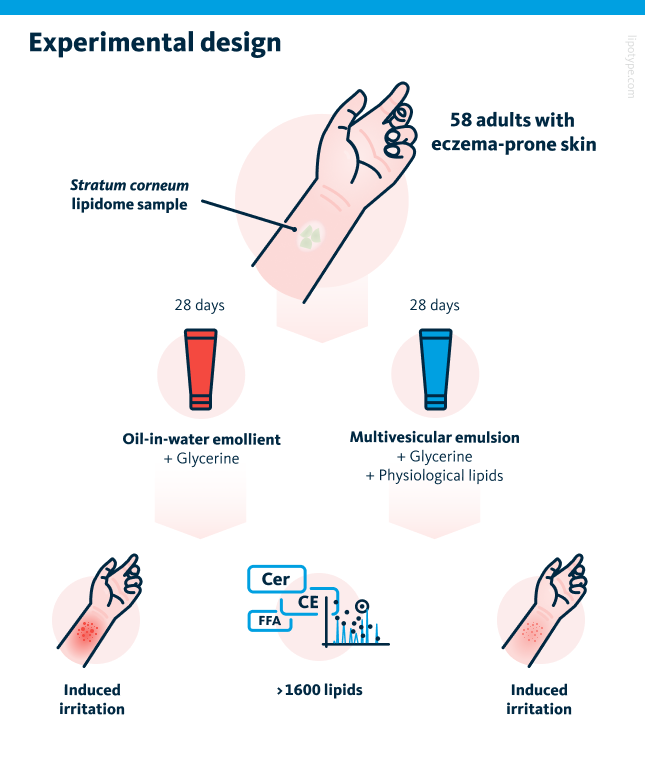
Transepidermal water loss (TEWL), a key indicator of how well the skin barrier prevents water from escaping the skin, is known to depend on lipid composition and is affected in eczema. TEWL was within the normal range at the start of the study and did not change with treatment overall. Tape stripping, which removes layers of the stratum corneum, predictably increased TEWL, reflecting reduced barrier integrity. Before treatment, there were no differences between the two test sites in TEWL after 20 tape strips (TEWL20). By the end of the treatment, skin treated with OW+G showed no meaningful change in barrier integrity. In contrast, areas treated with MVE+GL demonstrated clear improvement in barrier strength and cohesion.
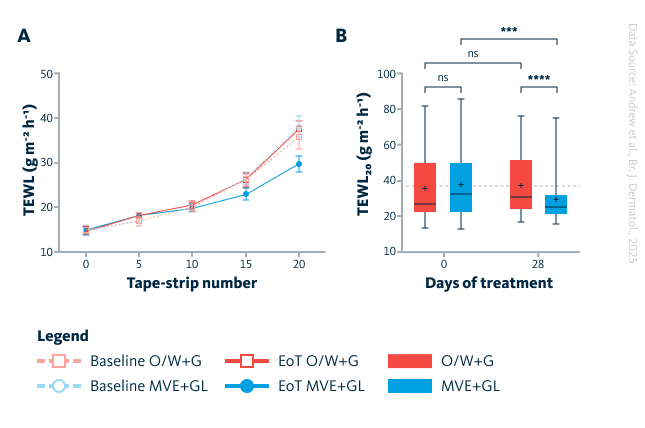
Transepidermal water loss (TEWL) changes upon MVE+GL skin treatment. A TEWL increased progressively with tape stripping, but sites treated with MVE+GL showed greater resistance compared to OW+G. B At the end of treatment, MVE+GL-treated skin displayed lower TEWL after stripping than at baseline, indicating stronger barrier function, while no significant change was observed with OW+G.
Andrew et al., Br. J. Dermatol., 2025, ljaf200, 10.1093/bjd/ljaf200
The researchers next evaluated whether treatment influenced the skin’s reaction to an irritant. Sodium lauryl sulfate (SLS), an irritant commonly used in testing barrier resilience, was applied under occlusion for 24 hours, and the resulting inflammation was measured through erythema (redness) and TEWL. At baseline, SLS triggered a strong response, with increased erythema index and TEWL. After treatment, skin treated with OW+G reacted to the irritant in the same way as before treatment. In contrast, sites treated with MVE+GL showed reduced sensitivity to an irritant, with more areas exhibiting no or only minimal redness compared to those showing moderate or severe erythema. The findings support existing evidence that not all emollients equally improve skin barrier function in pathological skin conditions like eczema.
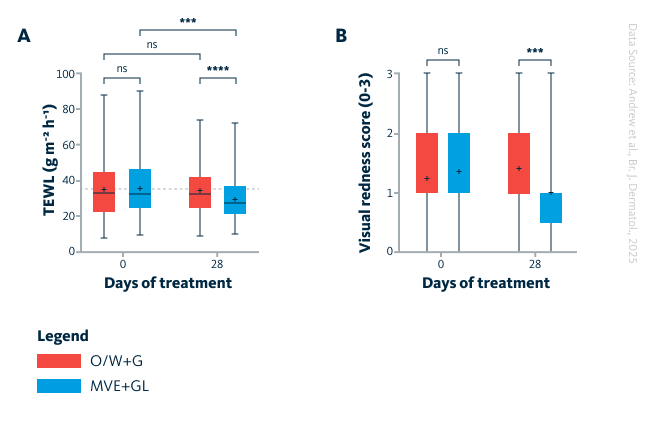
Changes in skin condition after exposure to an irritant. A Transepidermal water loss (TEWL) and B Visual redness scores showed clear differences between treatments. At the end of treatment, sites treated with MVE+GL had lower TEWL and reduced visible redness compared to baseline, while OW+G provided no significant protection.
Andrew et al., Br. J. Dermatol., 2025, ljaf200, 10.1093/bjd/ljaf200
Mass spectrometry lipidomics was used to profile ceramides, cholesterol, cholesteryl esters, and glycerides from stratum corneum samples collected by tape stripping at both baseline and the end of treatment in patients with eczema history. Lipidomics analysis revealed over 1600 lipid species, with 364 occurring in more than 70% of samples from at least one treatment group. Both formulations led to significant changes in a similar number of species (around 80 in each, with over 50 overlapping). However, only MVE+GL produced changes of twofold or greater. Across the analyzed lipid groups, the proportion of ceramides relative to total measured lipids increased with emollient use, although this change was not evident when normalized to protein content.
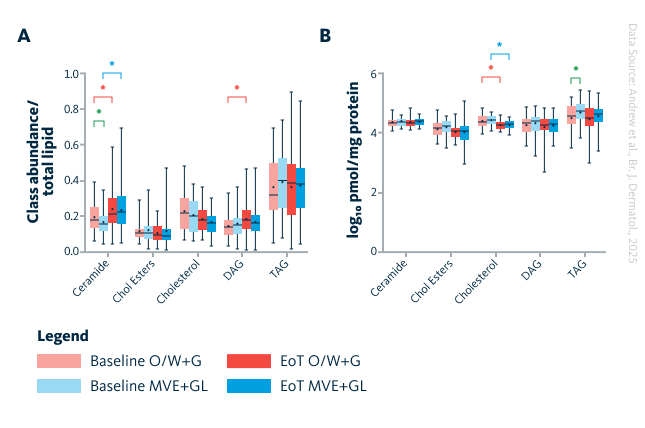
Changes in the relative abundance of major lipid classes analyzed in the stratum corneum following emollient treatment. A An increase in lipid classes with OW+G, MVE+GL, and between treatments. B After normalization to protein, most of these changes were no longer apparent, except for cholesterol and TAG. Green lines represent comparisons between treatments, red lines indicate changes over time with OW+G, and blue lines indicate changes over time with MVE+GL.
Andrew et al., Br. J. Dermatol., 2025, ljaf200, 10.1093/bjd/ljaf200
When ceramides were analyzed by subclass, only small overall changes were seen with treatment. In particular, NH and NS ceramide subclasses showed a significant increase between treatments. AS, NS, and EOS increased upon OW+G treatment, while EOH and EOdS showed a significant decrease. MVE+GL resulted in the AS and EOS increase.

Changes in the relative abundance of ceramide subclasses analyzed in the stratum corneum following emollient treatment. A Relative abundance of non-hydroxy- and alpha-hydroxy-ceramide subclasses expressed as a proportion of total non-hydroxy- and alpha-hydroxy-ceramide subclasses upon OW+G and MVE+GL treatment. B Relative abundance of esterified omega-hydroxy ceramide subclasses normalized to total abundance of esterified omega-hydroxy ceramide subclasses. Green lines represent comparisons between treatments, red lines indicate changes over time with OW+G, and blue lines indicate changes over time with MVE+GL.
Andrew et al., Br. J. Dermatol., 2025, ljaf200, 10.1093/bjd/ljaf200
Further analysis by chain length revealed notable effects for ceramides containing 18-carbon sphingoid bases (SBs) and 18- or 24-carbon acyl chains. MVE+GL treatment increased the relative abundance of most ceramide subclasses with 18-carbon SBs, with six out of eight subclasses showing measurable gains, several of which remained significant when adjusted for protein content. By comparison, OW+G led to increases in only three subclasses, and just one was significant after protein normalization.
NP(18), AP(18), and AS(18) ceramides were consistently higher in MVE+GL-treated skin than in OW+G-treated skin. An increase in the proportion of 18-carbon SB ceramides across most subclasses was linked to stronger skin barrier integrity. No clear association was observed between acyl chain length or total chain length and barrier performance in this analysis. Overall, ceramide species linked to stronger barrier integrity rose more with MVE+GL than with OW+G, supporting the idea that targeted lipid supplementation contributes to the treatment benefits observed.

Changes in ceramide species with an 18-carbon sphingoid base analyzed in the stratum corneum following emollient treatment. Relative abundance of non-hydroxy- and alpha-hydroxy-ceramide species with an 18-carbon sphingoid base expressed as a proportion of total non-hydroxy- and alpha-hydroxy-ceramide subclasses upon OW+G and MVE+GL treatment. Green lines represent comparisons between treatments, red lines indicate changes over time with OW+G, and blue lines indicate changes over time with MVE+GL.
Andrew et al., Br. J. Dermatol., 2025, ljaf200, 10.1093/bjd/ljaf200
Further analysis allowed for the identification of ten lipid species most strongly linked to better barrier integrity by identifying species negatively associated with TEWL20. Practically, that means that higher TEWL levels corresponded to stronger skin barrier function. MVE+GL treatment increased six ceramide species (from AdS, NH, NP, and AS subclasses) known to support barrier function. In contrast, higher levels of NdS species were linked to weaker barrier integrity, greater dryness, and higher water loss. The shift from NdS toward protective ceramides with MVE+GL likely explains the observed improvements in skin barrier performance.
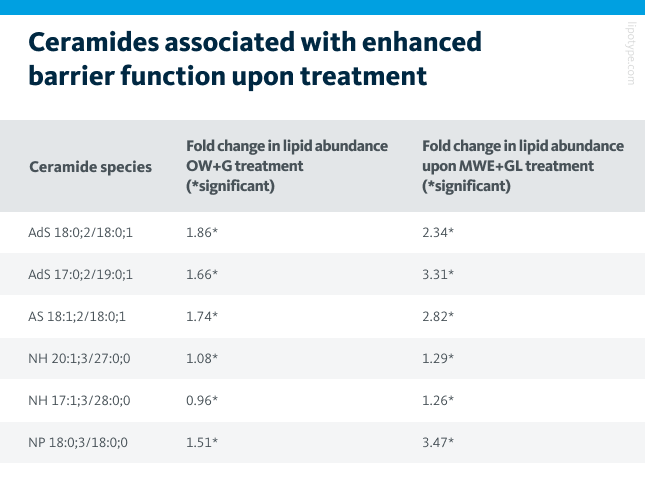
Treatment with MVE+GL appears to enhance skin barrier integrity, potentially by stabilizing lipid lamellae organization and corneodesmosomes, the key adhesive structures in the stratum corneum, or by reducing the penetration and protein-binding capacity of irritants. An additional anti-inflammatory effect, lowering skin sensitivity to irritants, cannot be excluded. Importantly, the observed changes in the stratum corneum lipid profile with MVE+GL are likely to contribute to these improvements in barrier performance in healthy skin and in the presence of skin diseases like eczema.
This study combined biophysical measurements with detailed lipid species analysis to evaluate how emollient use affects eczema-prone skin. While the standard oil-in-water emulsion with glycerine increased glycerine and certain ceramides in the stratum corneum, it did not improve barrier function. In contrast, the multivesicular emulsion containing both physiological lipids and glycerine produced marked changes in lipid composition, which were associated with stronger barrier function and reduced irritant responses. Since complete avoidance of irritants is rarely feasible in daily life, emollients enriched with physiological lipids and glycerine may offer superior protection compared to glycerine-only formulations, supporting better barrier resilience in eczema-prone skin.
Lipotype Skin Lipidomics technology can be used to characterize the skin lipid profiles in clinical and cosmetics research, as well as in fundamental dermatological research. For example, lipidomics helps to discover lipid species affecting the differentiation of human skin stem cells or support the research on how emollient application to dry skin affects the skin microbiome in addition to the lipidomics skin profiles.
Do our methods apply to your samples?
Let’s figure that out!



